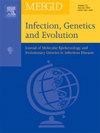泰国临床志贺氏单胞菌PSU59的基因组预警:耐药性和毒力特征
IF 2.6
4区 医学
Q3 INFECTIOUS DISEASES
引用次数: 0
摘要
志贺氏单胞菌(Plesiomonas shigelloides)是一种水生革兰氏阴性菌,越来越被认为是一种具有抗微生物药物耐药性(AMR)潜力的新兴病原体。这项研究提供了一种基于基因组的警报,从泰国的一名患者中分离出志贺杆菌PSU59。全基因组测序(WGS)显示3.6 Mb的基因组草图(38 contigs, 51.9% GC)编码3265个编码序列和129个RNA基因。共鉴定出13个AMR基因,包括外排泵(adeF、tet(A))、靶修饰因子(dfrA1、sul2)和氨基糖苷失活酶。侧翼抗性基因的移动遗传元件(MGEs)提示水平基因转移(HGT)。毒力分析显示48个因素,特别是鞭毛基因(fliM, fliN, flhA)与运动性有关。系统发育比较表明,PSU59属于进化支系3,与一种食物来源的菌株密切相关。这些结果突出了志贺氏杆菌PSU59的致病性和耐药潜力,并强调了基因组监测在追踪未被认识的病原体中新出现的威胁方面的重要性。本文章由计算机程序翻译,如有差异,请以英文原文为准。
Genome-based alert on a clinical Plesiomonas shigelloides PSU59 from Thailand: Resistance and virulence features
Plesiomonas shigelloides, an aquatic Gram-negative bacterium, is increasingly recognized as an emerging pathogen with antimicrobial resistance (AMR) potential. This study provides a genome-based alert on P. shigelloides PSU59, isolated from a patient in Thailand. Whole-genome sequencing (WGS) revealed a 3.6 Mb draft genome (38 contigs, 51.9 % GC) encoding 3265 coding sequences and 129 RNA genes. Thirteen AMR genes were identified, including efflux pumps (adeF, tet(A)), target modifiers (dfrA1, sul2), and aminoglycoside-inactivating enzymes. Mobile genetic elements (MGEs) flanking resistance genes suggest horizontal gene transfer (HGT). Virulence analysis revealed 48 factors, notably flagellar genes (fliM, fliN, flhA) linked to motility. Phylogenetic comparison placed PSU59 in Clade 3, closely related to a food-derived strain. These results highlight the pathogenic and drug-resistant potential of P. shigelloides PSU59 and underscore the importance of genomic surveillance in tracking emerging threats among under-recognized pathogens.
求助全文
通过发布文献求助,成功后即可免费获取论文全文。
去求助
来源期刊

Infection Genetics and Evolution
医学-传染病学
CiteScore
8.40
自引率
0.00%
发文量
215
审稿时长
82 days
期刊介绍:
(aka Journal of Molecular Epidemiology and Evolutionary Genetics of Infectious Diseases -- MEEGID)
Infectious diseases constitute one of the main challenges to medical science in the coming century. The impressive development of molecular megatechnologies and of bioinformatics have greatly increased our knowledge of the evolution, transmission and pathogenicity of infectious diseases. Research has shown that host susceptibility to many infectious diseases has a genetic basis. Furthermore, much is now known on the molecular epidemiology, evolution and virulence of pathogenic agents, as well as their resistance to drugs, vaccines, and antibiotics. Equally, research on the genetics of disease vectors has greatly improved our understanding of their systematics, has increased our capacity to identify target populations for control or intervention, and has provided detailed information on the mechanisms of insecticide resistance.
However, the genetics and evolutionary biology of hosts, pathogens and vectors have tended to develop as three separate fields of research. This artificial compartmentalisation is of concern due to our growing appreciation of the strong co-evolutionary interactions among hosts, pathogens and vectors.
Infection, Genetics and Evolution and its companion congress [MEEGID](http://www.meegidconference.com/) (for Molecular Epidemiology and Evolutionary Genetics of Infectious Diseases) are the main forum acting for the cross-fertilization between evolutionary science and biomedical research on infectious diseases.
Infection, Genetics and Evolution is the only journal that welcomes articles dealing with the genetics and evolutionary biology of hosts, pathogens and vectors, and coevolution processes among them in relation to infection and disease manifestation. All infectious models enter the scope of the journal, including pathogens of humans, animals and plants, either parasites, fungi, bacteria, viruses or prions. The journal welcomes articles dealing with genetics, population genetics, genomics, postgenomics, gene expression, evolutionary biology, population dynamics, mathematical modeling and bioinformatics. We also provide many author benefits, such as free PDFs, a liberal copyright policy, special discounts on Elsevier publications and much more. Please click here for more information on our author services .
 求助内容:
求助内容: 应助结果提醒方式:
应助结果提醒方式:


